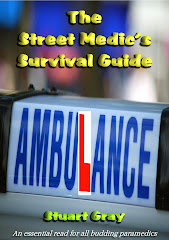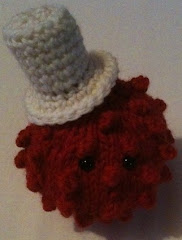
Nine emergency calls. One conveyed, one refused and seven required an ambulance.
Another chance to read my book while it was quiet this morning. Usually I don’t bother picking up a book when I’m on duty because I don’t like getting into something and having to dog-ear the page half way through a paragraph. I have been taking the risk recently for two reasons: it has been slower to kick off each morning (weather relevant) and I get bored if I’m not doing something constructive.
I dog-eared the book for a 60 year-old male with DIB, got on scene and realised I wasn’t required. There was a crew already attending to the patient, who was staggering out of a shop with them, drunk, unsteady and a little wheezy.
Once it starts, it usually continues (like rain). I went straight to a 51 year-old man having an asthma attack outside a pub in south London. He had been suffering since the night before and had used up his inhaler, with very little effect. He was able to speak but had to draw breath every few seconds. His sats were low and he was struggling a bit. I started his treatment by the roadside and the crew arrived just as I was about to deliver salbutamol into his lungs. It was raining and miserable, so we got him into the ambulance and continued his care in a warmer, drier environment. Then I said my goodbyes and left the crew to it. The patient was already improving.
I managed to get near to my station (the plan was to have a coffee and a biscuit, if there were any left) but I found myself driving north for a 90 year-old lady who was ‘unconscious on the floor’. I thought, given the age and the call description, I might be heading toward a suspended patient. When I got on scene I couldn’t get into the premises. Large gates blocked my way and they were locked. Nobody was at them to meet and greet, so I asked Control to let the caller know I was waiting outside. It took four minutes to finally get in and by that time the ambulance had arrived too.
Once inside, we discovered a fully conscious elderly lady sitting on her kitchen floor. Apparently she had just had a ‘funny turn’ and collapsed. The woman who called had mistaken the interlude of lucidity for death I think and had panicked. She admitted as much when we went inside the house. I think you have to live a long and relatively trouble-free life to have such a melodramatic way of thinking when you deal with an acute situation. Still, the patient needed to go to hospital and have the mishap investigated properly, so although the call description was a little over the top, the situation still necessitated an ambulance.
I got an ‘ouch’ job after that. A 20 year-old woman who was placing shoes on a rack in a shop. The rack was made up of lots of shiny metal posts which stuck out of the wall. She got too close to them and managed to thrust her eyeball directly onto one. Although she wasn’t impaled (that would be bad), she did tear the cornea right across, causing visual problems and a whole lot of pain. She cried a bit and then settled down when I covered the eye to stop her touching it. Although there is no need to patch an eye damaged in this way, it has a reassuring psychological short term effect.
I took her to hospital in the car and she was calm (and in less pain) when she got there. I even treated her (by request I should add) to a ‘fast’ ride in her wheelchair. I always offer a fast or slow trip down the corridor – I believe it’s a tax-payer’s right to have a choice. She was squealing like a child on a roller-coaster.
My next call was to an EP fit. A 21 year-old man’s grand-parents had called because they were concerned about his behaviour. He was vague, staring into space and didn’t seem to know the time of day. He was also quite fidgety. I asked him about his history with epilepsy but it was undefined – no doctor had actually diagnosed him yet but he was given prophylaxis in case he ‘ever went funny again’ – I found that quite surprising. The drug had been left on a shelf and only taken when he thought he might need it. A year had elapsed since he last used it.
I watched him moving restlessly on his bed and asked him pertinent questions about his other habits, including drug use. He admitted he had smoked cannabis earlier and had been drinking too. I suggested the cannabis might have more to do with his behaviour than epilepsy. He agreed in principle.
The crew arrived and he was taken to hospital anyway. He wasn’t an emergency but my colleague, quite rightly, thought the drug he had been prescribed didn’t fit the bill and that a doctor needed to re-evaluate what this young man required. A diagnosis would be a good start.
A 40 year-old man who had abdominal pains after drinking and who had a long history of duodenal ulcer called 999 to complain of ‘chest pain’. He didn’t have chest pain but he knew that saying he did it would elicit a faster response – clever chap. I’m not being sarcastic this time around because, although he was complaining of abdominal pain and coupled with his habit of drinking on an ulcer he was obviously asking for trouble, his ECG showed deep Q waves in some of the leads – this may indicate significant heart disease or an underlying MI (or a previous MI) – well, it’s possible. So, as far as I was concerned, his pain could be something or nothing – but probably something.
A hit and run call for a 40 year-old male who had sustained a suspected fractured arm as a result. I thought I was heading toward another miserable job where yet another innocent person had copped it from a sleaze ball driver who doesn’t care enough to stop when he damages someone. Fortunately, it was ‘not as given’ – the patient had a minor arm injury, if any at all and the driver had stayed where he was after clipping the victim’s bicycle.
After my break I wandered back into the West End and got a Red1 call for a suspended male in the street. As I rushed to get there (we all rush to get to these jobs) it was updated and now read ‘ineffective breathing’. I was beginning to smell a rat and because I was looking for a windmill I over-shot the location (which was vague at best) and had to turn around and head back to where I thought the caller might be. I stopped and looked around – nothing. The cycle responder arrived and he looked as lost as I did. Luckily a passer-by told me that the man was further down the street (I had just shot past him), so we turned ourselves around and headed to his rescue.
He was a drunk and he was sleeping on the pavement. He had his tell-tale bottle of booze on him and his breathing was better than mine, so he didn’t need to go to hospital and we cancelled the numerous ambulances that were about to descend on this ‘suspended’ patient.
The person who called us out for this guy was nowhere to be seen. He must have been intelligent enough to call 999 and describe the patient but he lacked the common sense to go and physically check his facts. This is very common; a lot of people call us when they believe someone is dead in a doorway. We generally get there, prod the patient a couple of times and they wake up - empty cans will often roll around next to them.
If only these people would look closely at the person they are son worried about, or stick around when we get there. There’s more than one way to hit and run I guess.
Be safe.















9 comments:
Love the wheelchair push, so can you come and push me fast in mine please.
Wot no comment about my fast push.
You are a wonderful person I have come to that conclusion whilst reading your blog.
anonymous
Just close your eyes and say "wheee" - there you are, one fast push!
:-)
I closed my eyes and said "wheee" and nothing.
Your blog is very interesting. I really enjoy reading about your point-of-view, being a paramedic and all. Thanks for sharing!
clinical supplies
Thanks. Keep reading
:-)
I would like to work for the LAS.
karl p
Then you should log on to the LAS website www.londonambulance.nhs.uk/careers/careers1.html
I don't think we are recruiting now though.
Post a Comment